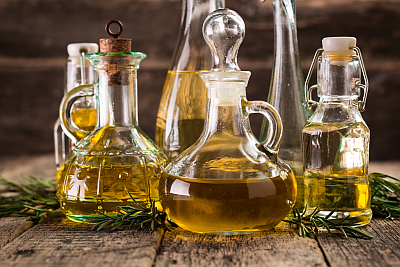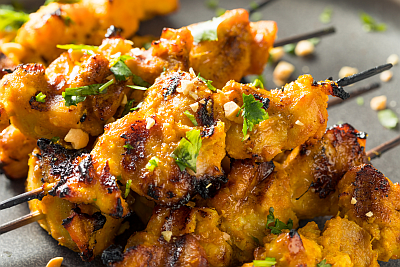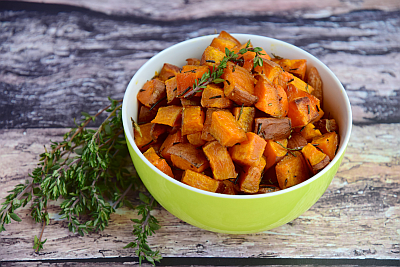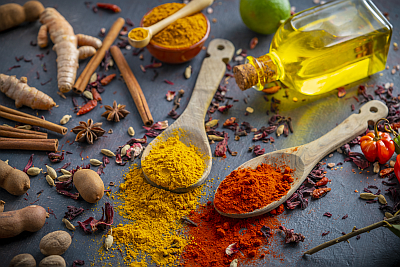We’re willing to bet there’s a bottle or two of cooking oil lying around your kitchen just waiting to transform your next culinary creation. Not only is this golden liquid the secret to browning and crisping up your favorite foods, but oils deliver incredible flavor with health benefits.

While it can be easy to take this everyday ingredient for granted, the multiple varieties on your grocery store shelf mean all the more possibilities.
But is there a specific cooking oil the experts recommend? What is the range of flavor? Does the nutritional value hold up across all varieties? Jacob Schaller and Stacy Borders, food scientists at our partner Cargill (one of the largest cooking oil makers), give us the cooking oil low-down below.
YOUR COOKING OIL LINE-UP
It can be daunting to browse the cooking oil selections at the grocery store. Lined up side-by-side, those pretty bottles all look the same, don’t they?
“Technically, you can use most oils for most cooking jobs,” shares Jacob. “But for the best outcome, choose your oil based on how you’re going to use it, your personal nutrition goals, and your flavor preferences.”

Jacob and Stacy cover some common cooking oils and where they tend to shine.
Canola: This is a favorite among the Cargill team for its neutral taste. “Canola has a clean flavor that lets the food come through—plus it is plentiful with polyunsaturated fats, making it a healthy choice,” Jacob shares.
Olive: With its quintessentially Mediterranean flavor, olive oil is great for sautéing, dipping warm bread, roasting, and as a base for salad dressings. Because it is pressed and not refined, extra-virgin olive oiloffers a more intense flavor and lower smoke point than regular oil which requires a bit more attention to stay safe.
Soybean: Often masquerading as “vegetable oil,” soybean oil can have a mild, buttery flavor. It’s an affordable, all-purpose pick. However, it can leave a gummy residue on your pans over time.
Peanut: Peanut is widely used for frying thanks to its high smoke point. Most people with a peanut allergy can safely consume highly refined peanut oil.

Corn: Adds a subtle sweetness and golden color that many cooks prefer, and is also ideal for frying foods.
Sunflower: Is growing in popularity, with a one-of-a-kind flavor. “We find that sunflower oil tastes nutty on its own, with a very mild flavor,” Jacob explains.
Avocado: Almost as popular as avocados themselves! High in heart-healthy fats, avocado oil has a very high smoke point of 520 degrees, so you can use it for just about anything.
Coconut: This one has been in the limelight too, but be careful how you use it. “Coconut oil has a low smoke point, so it’s not recommended for frying. It’s also quite high in saturated fat,” Stacy warns, a Business Development Technical Services Manager with Cargill.

This list is just the beginning! Our friends at Cargill can attest there are a wide variety of cooking oils, each with different benefits. “Recently we’ve seen rice bran, grapeseed, and walnut oil trending, too,” Stacy shares. “Finding the right cooking oil is all about how and what you like to cook.”
OILS AND FLAVOR PROFILES
Now that you know the ins and outs of oil, it’s time to get cooking! Below is a chart that breaks out flavor combination ideas and the right oil to use (as well as some tried-and-true recipes).
| Flavor Profile | Oil | Recipe to Try |
| Spicy | Canola | Spicy Lime Marinade |
| Sweet | Corn | Maple Thyme Sweet Potatoes |
| Olive | Watermelon Tomato Salad | |
| Savory | Canola | Turmeric Ginger Vinaigrette |
| Olive | Garlic Shrimp Zoodle Bowl | |
| Peanut, Sunflower |
Chicken Satay Skewers | |
| Soybean (Vegetable) |
Sesame Crusted Tilapia with Garlic Vegetables |
OIL FAST FACTS
There are seemingly endless need-to-know facts for cooking with oil. Here, Stacy and Jacob impart their expert knowledge with four very takeaways to use next time you’re in the kitchen.

- Remember, healthy fats—like oil—are good for our bodies. As we’ve talked about before, fat is a necessary part of a well-rounded diet. Fats add depth of flavor to dishes and can also help keep us full after eating. There are even some vitamins that need fats to be absorbed properly. Most cooking oils (all of those named above except for coconut!) are a great source of unsaturated fats. Diets containing unsaturated fats are associated with good heart health, lower risk of type 2 diabetes, and a reduced risk for certain cancers.
- Store your cooking oil in the pantry, not next to the stove. That’s because “exposure to light, heat, air, and moisture can all affect oil’s quality and taste,” Jacob tells us. “Store most oils in a cool, dark place like your pantry or a cabinet.”
- When cooking, keep smoke points in mind. You will see this expressed as a temperature, ranging from 375 to 475 degrees Fahrenheit. “The smoke point is the temperature you can safely heat an oil or fat to before it will literally start to smoke,” explains Jacob. “Exceeding the smoke point can result in fires—something you definitely want to avoid.”
- There is a difference between oil and shortening. Oil and shortening are often interchangeable in recipes but there are some differences. “Oil is liquid at room temperature, while shortening is solid at room temperature,” Stacy explains. “Shortening works well in baking and lends a traditional flavor to pie crusts, like grandma used to make.” She adds that beyond baking, many health-conscious cooks prefer to use oil for the health benefits that come with polyunsaturated fat.
We hope these insights from Cargill have inspired you to broaden your cooking oil repertoire! Find many more ways to cook with this pantry staple on our recipe page and Instagram.
Note: Since everyone’s health history and nutritional needs are so different, please make sure that you talk with your doctor and a registered dietitian to get advice about the diet and exercise plan that‘s right for you.

